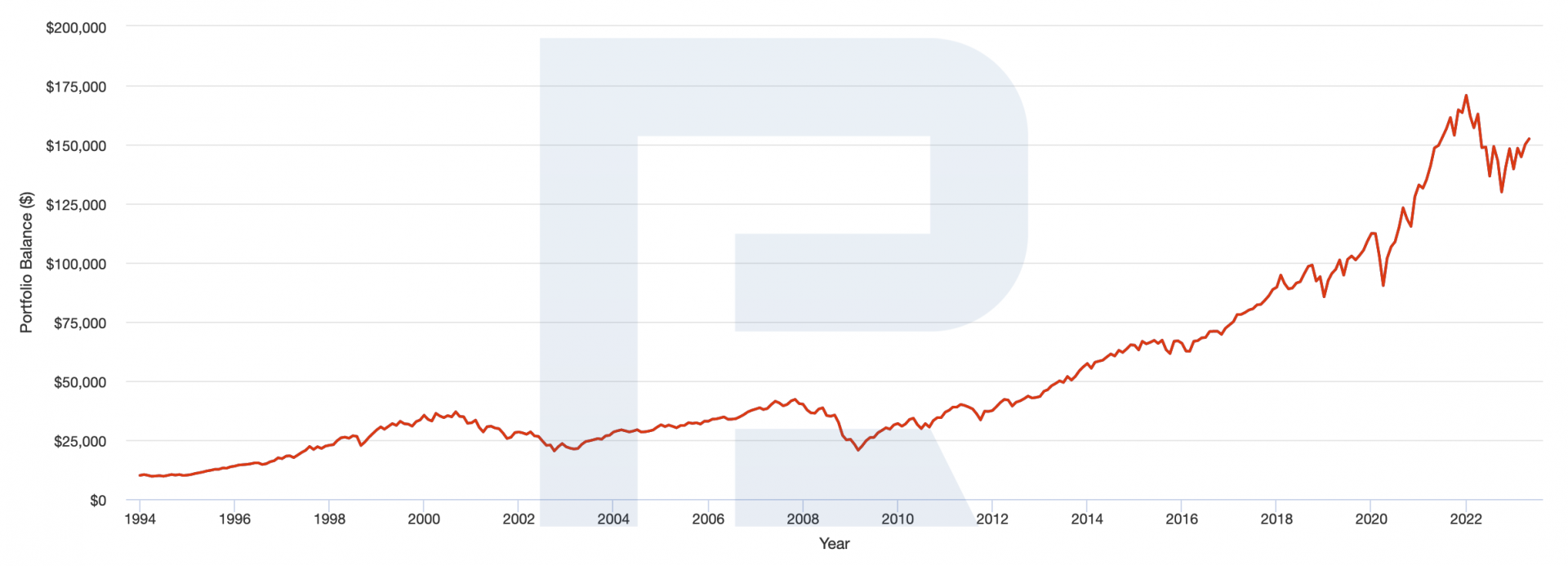The Buy-and-Hold Strategy: A Time-Tested Approach to Long-Term Investing

4 minutes for reading
The buy-and-hold strategy is one of the most popular investment approaches. It is based on the idea of holding assets over the long term with the aim of generating returns from the rise in their prices, and dividend payouts, if any. Today we will look at its basic principles, benefits, and risks, and explain how prominent investors have used it.
Historical performance of the buy-and-hold strategy
The buy-and-hold strategy is one of the most popular and widely used investment strategies. Let’s look at its historical performance with the Vanguard 500 Index Investor as an example. According to Portfolio Visualizer, the average annual total return of the index from January 1994 to April 2023 inclusive was 12.93%. The highest annual return during this period reached 32.18%, and the minimum annual return was 18.23%.

Buy-and-hold strategy principles
- Hold assets in a portfolio for an extended period of time, starting from five years
- Select financial instruments with long-term growth potential and strong fundamental indicators
- Spread investments across different asset classes and sectors to reduce risks and increase potential returns
- Totally ignore short-term market fluctuations
- Regularly rebalance the portfolio by buying and selling assets, while considering investment goals and significant changes in market conditions
Buy-and-hold strategy advantages
- No need for frequent active trading operations
- Reduced transaction costs
- No need for constant monitoring of the market and quick decision making
- Reduced stress levels
- Increased total profit, subject to regularly reinvested dividends
Buy-and-hold strategy possible risks
- Loss of long-term profit due to the premature sale of assets in case the investment goals change
- Difficulty in finding and selecting financial instruments with strong fundamental indicators and long-term growth potential
- Mistakenly choosing the wrong company for long-term investing
- Investor is not prepared for declines in the value of short-term and long-term investments and is unable to hold open positions for a long period of time
Warren Buffett and the buy-and-hold strategy
Warren Buffett is one of the most successful and respected investors in the history of the financial world. He holds the position of CEO and Chairman of the Board of Directors of Berkshire Hathaway (NYSE:BRKb).
Buffet demonstrated through his approach to investing that the buy-and-hold strategy can be effective if companies are selected based on fundamental analysis and with a long-term view.
Investment rules from the Oracle of Omaha:
- Invest for the long term.
- Do not track every price fluctuation.
- Invest in what you understand.
- Be guided by the value of the company.
- Buy stocks at a reduced price.
- Learn to invest.
- Pay attention to dividends.
An example of Buffett’s investing with the buy-and-hold strategy
Berkshire Hathaway bought Coca-Cola Company (NYSE: KO) stock for the first time in early 1988: it purchased about 200 million shares. At that time, they traded at about 2.5 USD per unit.
The Coca-Cola Company was already a leader in its industry at that time. In 1989, Berkshire Hathaway acquired shares in this company for another 600 million USD. During that year, the stock rose from 2.72 to 4.83 USD per unit.
As at 31 March 2023, Warren Buffett’s company owns 400 million shares of Coca-Cola Company, accounting for 9.2% of the portfolio. From January 1988 to March 2023 inclusive, the stock price increased from 2.5 to 62.03 USD.
Buffett has pursued a buy-and-hold strategy regardless of short-term market fluctuations and changes in the value of Coca-Cola Company shares. For example, while these shares lost 54% in price from July 1998 to February 2003 inclusive, the investor continued to hold them in his portfolio.
Summary
The buy-and-hold strategy is an approach to investing based on the assumption of the long-term appreciation of the selected assets and the growth of markets in general. This approach may be of interest to investors who focus on long-term investments and want to avoid frequent trading.
This tactic will require patience, discipline, experience, and time for asset analysis and selection. However, like any other strategy, Buy-and-Hold has its downsides, so it is worth carefully analysing your investment goals and risk appetite before applying it.
* – Past performance is not a reliable indicator of future results or future performance.
The material presented and the information contained herein is for information purposes only and in no way should be considered as the provision of investment advice for the purposes of Investment Firms Law 87(I)/2017 of the Republic of Cyprus or any other form of personal advice or recommendation, which relates to certain types of transactions with certain types of financial instruments.








 are complex instruments and come with a high
are complex instruments and come with a high  of losing
of losing  rapidly due to
rapidly due to  . 65.68% of retail investor accounts lose
. 65.68% of retail investor accounts lose  when trading
when trading  with this provider. You should consider whether you understand how CFDs work and whether you can afford to take the high
with this provider. You should consider whether you understand how CFDs work and whether you can afford to take the high